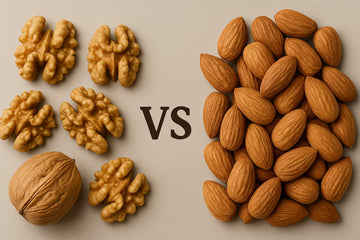When it comes to nutrient-dense snacks, nuts often top the list, and almonds and walnuts are two of the most popular choices among health-conscious individuals. Both nuts are delicious, packed with vital nutrients, and bring numerous health benefits. But the question often arises: which nut is better for your overall health? In this detailed comparison of walnuts vs almonds, we'll explore their nutritional profiles, health benefits, and potential downsides to help you make an informed decision.
Walnuts vs Almonds: A Nutritional Comparison
|
Category |
Walnuts |
Almonds |
|
Calories (per 30g) |
185 |
170 |
|
Fat |
18.5g |
15g |
|
Protein |
4.3g |
6g |
|
Carbohydrates |
4g |
6g |
|
Vitamin E |
1.3% of DV |
45% of DV |
|
Fiber |
2g |
3g |
|
Magnesium |
11% of DV |
19% of DV |
|
Phosphorus |
8% of DV |
11% of DV |
|
Omega-3 (ALA) |
High (highest among nuts) |
Very low |
|
Weight Loss Support |
Some evidence, limited studies |
Strong evidence; reduces visceral fat, enhances fullness |
|
Keto-Friendliness (Net Carbs) |
2g net carbs |
3g net carbs |
|
Heart Health |
High ALA, ellagitannins, and phytosterols reduce LDL and blood pressure |
Vitamin E, flavonoids, and unsaturated fats reduce LDL and triglycerides |
|
Brain Health |
Strong evidence; improves memory and cognitive function |
Limited evidence; some animal studies show potential |
|
Blood Sugar Control |
Mixed evidence; minimal effect |
Strong evidence; lowers glycemic index, slows sugar absorption |
|
Antinutrients (Phytic Acid) |
Present; may inhibit mineral absorption |
Present; may inhibit mineral absorption |
|
Allergen Potential |
Higher allergenic probability |
Lower allergenic probability |
Health Benefits of Almonds and Walnuts
Both almonds and walnuts bring extensive health advantages. But each shines distinctly in various health contexts.
Weight Management
When it comes to managing weight, almonds might offer greater benefits. Despite their calorie density, studies have consistently found almonds beneficial for weight loss, particularly in reducing visceral fat, which is strongly linked to health risks such as heart disease and diabetes. The high protein in almonds, combined with fibre and unsaturated fats, can enhance satiety.
Moreover, almonds are known for their role in maintaining hair health, too!
Walnuts, too, have shown promise in aiding weight loss when included moderately in calorie-controlled diets. But the evidence is less robust compared to almonds.
Heart Health
Both walnuts and almonds support heart health, but through slightly different mechanisms.
Walnuts contain high levels of ALA omega-3 fatty acids, phytosterols, and polyphenols. These nutrients work synergistically to lower LDL (bad cholesterol), reduce inflammation, and promote vasodilation.
Meanwhile, almonds boast a high content of antioxidants like flavonoids and vitamin E. These antioxidants are known for reducing LDL cholesterol and improving overall cardiovascular health. Regular almond consumption has been shown to lower triglycerides and cholesterol levels.
Brain Health
When examining brain health specifically, walnuts clearly have the edge. Their substantial omega-3 content, along with potent antioxidants, actively reduces inflammation and oxidative stress, which are critical factors in cognitive decline and memory loss.
Studies indicate that regular walnut intake can improve memory performance and cognitive function. In addition, walnuts are also valued in skincare for their anti-inflammatory properties.
Almonds, despite their nutritional excellence, show less pronounced benefits regarding human brain health.
Blood Sugar Control and Diabetes
For blood sugar regulation, almonds appear more effective. Their beneficial effects on blood sugar levels are largely attributed to their high fibre, protein, and healthy fat content. Research consistently indicates that almonds can improve glycemic control, making them diabetic-friendly nuts.
Walnuts and diabetes management studies present mixed results, with minimal impact noted on fasting blood sugar levels. Hence, almonds are generally more recommended for diabetic individuals.
Downsides of Almonds and Walnuts
While both nuts are beneficial, there are some downsides to consider.
Both almonds and walnuts contain phytic acid, an antinutrient that can bind to minerals like calcium, iron, and zinc. The antinutrient can reduce their absorption.
Additionally, both can trigger allergies. Even then, walnuts are slightly more allergenic compared to almonds.
Their high calorie and fat content, although mostly healthy, means portion control is important. Overconsumption could lead to unwanted weight gain.
Almonds and Walnuts in Special Diets
If you're following specialised diets such as keto, both nuts can fit well. In fact, walnuts have slightly fewer net carbs (2 grams vs almonds' 3 grams per serving). Both are great snack options when consumed in moderation.
Practical Recommendations: Almonds or Walnuts?
Choosing between almonds and walnuts doesn't need to be a strict either-or scenario. If your primary focus is weight loss, blood sugar control, and getting the most protein (approximately 21 grams per 100 grams of almonds), almonds are your best bet. They also have fewer calories per nut (calories in one almond average about 7).
On the other hand, if your focus is on enhancing brain health, reducing inflammation, and improving heart health through omega-3 intake, walnuts may serve you better.
Suggested read-: Walnut Benefits for Skin:
Bottom Line: Walnuts vs Almonds
Both almonds and walnuts are nutritionally valuable nuts, providing many health benefits. Almonds are particularly strong in protein, minerals, and managing blood sugar and weight loss, while walnuts excel in omega-3 fatty acids and promoting brain and heart health.
Incorporating both into your diet can maximise the nutritional and health benefits of almonds and walnuts. Ultimately, the choice depends on your specific health goals and personal taste preferences. Above all, remember the wisdom: “Anything in excess is not good!”
Explore and buy walnut and almonds online at My Pahadi Dukan
FAQs
How many walnuts should a diabetic eat daily?
For individuals with diabetes, consuming around 28–56 grams (1–2 ounces) of walnuts daily is generally considered safe and beneficial.
What is the Badam nutritional value per 100g?
Per 100 grams, badam (almonds) provides approximately 579 calories, 21g of protein, and nearly 50g of healthy fats, mainly monounsaturated. It also has 21.6g carbohydrates, 12.5g fibre, and nutrients like Vitamin E (25.6mg), calcium (269mg), magnesium (268mg), and potassium (733mg).
How many almonds and walnuts to eat a day?
A healthy daily portion is around 20–23 almonds or 3–5 walnuts. It supports balanced nutrition without excess calories. However, individual needs may vary.
Almonds or walnuts for weight loss?
For weight loss, almonds may have a slight edge due to their lower calorie content, higher fibre, and protein levels. However, both almonds and walnuts can support weight management when eaten in moderation.
Walnuts vs almonds protein, which is higher?
Almonds have more protein than walnuts, offering about 21 grams per 100 grams compared to walnuts’ 15 grams. So, almonds are a better choice for those prioritising protein intake.
Walnuts vs almonds calories, which is higher?
Walnuts contain slightly more calories than almonds. A 1-ounce serving of walnuts has around 185 calories, while the same amount of almonds provides about 160–165 calories. So, almonds are a slightly lighter option.










